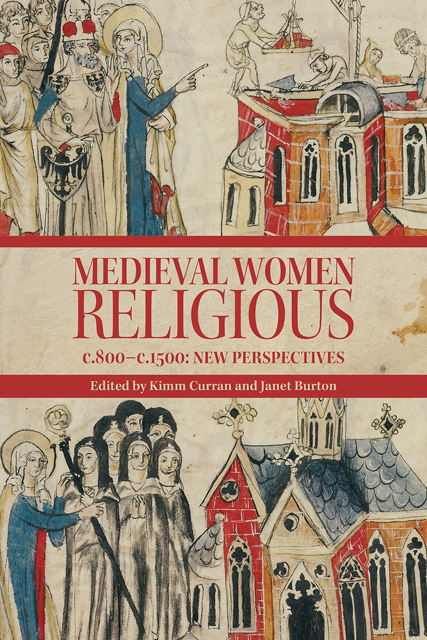Book contents
- Frontmatter
- Contents
- Illustrations
- Contributors
- Preface
- Abbreviations
- Introduction
- 1 Reform, Change, and Renewal: Women Religious in the Central Middle Ages, 800–1050
- 2 New Movements of the Twelfth Century: Diversity, Belonging, and Order(s)
- 3 Change and Renewal: Mendicants and Tertiaries in Later Medieval Europe
- 4 On the Fringes: Anchorites
- 5 ‘Quasi-religious’: Vowesses
- 6 Authority and Agency: Women as Heads of Religious Houses
- 7 Women Religious, Secular Households: The Outside World and Crossing Boundaries in the Later Middle Ages
- 8 Literacies, Learning, and Communal Reform: The Case of Alijt Bake
- 9 Family and Friends: Gift-giving, Books, and Book Inscriptions in Women’s Religious Communities
- 10 Communities of Medieval Religious Women and Their Landscapes
- 11 Materiality and Archaeology of Women Religious
- 12 Between Collective Memory and Individual Remembrance in Women’s Religious Communities
- Select Bibliography
- Index
- Miscellaneous Endmatter
1 - Reform, Change, and Renewal: Women Religious in the Central Middle Ages, 800–1050
Published online by Cambridge University Press: 08 June 2023
- Frontmatter
- Contents
- Illustrations
- Contributors
- Preface
- Abbreviations
- Introduction
- 1 Reform, Change, and Renewal: Women Religious in the Central Middle Ages, 800–1050
- 2 New Movements of the Twelfth Century: Diversity, Belonging, and Order(s)
- 3 Change and Renewal: Mendicants and Tertiaries in Later Medieval Europe
- 4 On the Fringes: Anchorites
- 5 ‘Quasi-religious’: Vowesses
- 6 Authority and Agency: Women as Heads of Religious Houses
- 7 Women Religious, Secular Households: The Outside World and Crossing Boundaries in the Later Middle Ages
- 8 Literacies, Learning, and Communal Reform: The Case of Alijt Bake
- 9 Family and Friends: Gift-giving, Books, and Book Inscriptions in Women’s Religious Communities
- 10 Communities of Medieval Religious Women and Their Landscapes
- 11 Materiality and Archaeology of Women Religious
- 12 Between Collective Memory and Individual Remembrance in Women’s Religious Communities
- Select Bibliography
- Index
- Miscellaneous Endmatter
Summary
In the final years of the fourteenth century, the Franciscan friar and chronicler Jacques de Guise recorded an account of a heated dispute between a group of early ninth-century Church reformers and the heads of several women's monastic communities in present-day Belgium and Germany. A major Church council had decreed that all communities of women religious would henceforth strictly observe the Rule of St Benedict and the message was relayed to all the convents in the area; however, the leaders of these places quickly agreed to appeal jointly against the reform. After much diplomatic wrangling involving the pope and Emperor Louis the Pious, a decision was made to hold a synod at the royal abbey of Nivelles to discuss the issue further. Bishop Walcand of Liège opened the meeting by reiter¬ating the council's precepts. But once he had finished speaking the heads of these women's communities rejected his call and responded with one voice:
First, we protest with God and all of those listening, that we have never vowed to the Rule of St Benedict. Second, we promise to remain chaste, but we will not let ourselves be forced to accept the veil. Third, we are prepared to vow ourselves to obedience to our abbesses and an honest life. Fourth, if this response is not enough, we are prepared to lodge further appeals.
These words sent shockwaves through the meeting. When Walcand sternly reminded the women of their duty to comply with the reform all remained silent, except for Abbess Doda of Sainte-Waudru in Mons. She, according to the chron¬icler, ‘spoke inappropriately’. The organisers hastily dissolved the synod and subsequently convened with a number of prominent clerical and lay lords to work out ‘a short instruction for an honest life without any vows, except for that of any Christian’, in order to give the women at least some written guidelines. This text they then sent to the heads of these women's monastic communities. They added that henceforth the heads of these women's monasteries and their subjects would be known as ‘secular religious’ instead of ‘nuns’. The account closes with the ominous statement that Walcand ended by deposing many of the heads of these women's communities as a token of their eternal punishment, and that he installed in their place noblemen as secular abbots.
- Type
- Chapter
- Information
- Medieval Women Religious, c.800-c.1500New Perspectives, pp. 22 - 42Publisher: Boydell & BrewerPrint publication year: 2023



